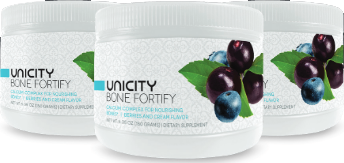SUMMARY
Calcium is known for its significance in building strong bones. Bone development is a multi-faceted process; however, recent studies have shown that calcium supplementation by itself might not be enough to build healthy bones and slow the effects of aging. Calcium supplementation requires a proper balance with other nutrients. Unicity Bone Fortify provides a highly bioavailable form of calcium (CCM), along with several other ingredients that assist bone development in a heart-healthy way.
Magnesium is an important mineral for the body that helps with hundreds of enzymatic reactions, including some reactions necessary for bone growth. Studies show that only a third (32%) of the U.S. population meets the dietary reference intake (DRI) for magnesium. Vitamin D assists calcium absorption, and helps in the production of osteoblasts (cells that synthesize bone). Vitamin K2 modulates gene expression of osteoblasts and contributes to calcium transport by activating two calcium-binding proteins—osteocalcin and matrix GLA protein.
Figuratively speaking, Unicity Fortify provides the body with both the raw materials and the tools it needs to build bones. If the body receives solely calcium, then a great deal of the calcium will not be absorbed and utilized by the body and will instead float around without purpose in the circulatory system. By providing the body with additional supplementation (magnesium, vitamin D, vitamin K2, and other trace minerals), it has the tools it needs to utilize calcium correctly. As a member of Unicity’s Genomeceutical™ line of products Fortify helps regulate the genes involved in calcium and magnesium uptake, as well as the genes that affect production of collagen in bone cells.
ACTIVE INGREDIENTS
Calcium Citrate Malate (CCM) –
Calcium, along with physical exercise, is one of the most important influences in bone mass and density.1 Compared with the average modern diet, Paleolithic hunter-gatherers consumed more calcium in their diets and had stronger bones (an average of 17% more bone density). CCM is the most bioavailable form of calcium, and has been shown to be more effective than calcium carbonate at supporting healthy bones. Combined with vitamin D and trace minerals, calcium helps support healthy bones in postmenopausal women.2
Magnesium Citrate –
Magnesium helps transport ions, including calcium, and it plays a structural role in bone formation.
Vitamin D3 –
Most Americans have low vitamin D levels, but this product contains a vitamin D amount that is recommended by current science. Vitamin D enhances the absorption of calcium and magnesium in the body by regulating the genes that govern this process. Vitamin D has been used in conjunction with calcium to support healthy bones in postmenopausal women.2 It also regulates the expression of the genes involved with osteoblasts.3
Vitamin K2 (MK-7) –
While the liver tends to retain vitamin K1, vitamin K2 integrates with lipoproteins, and ends up travelling to other areas of the body.4 Long-term studies of vitamin K2 show that it helps maintain healthy bones in post-menopausal women. The specific form of vitamin K (MK-7) found in Unicity Bone Fortify has a longer biological half-life than other forms, to assure it remains in circulation to assist the body. Vitamin K2 has
been shown to up regulate the genes that enhance the accumulation of collagen in bone cells, in addition to its known role as an activating agent with certain calcium-binding proteins.5
Boron Citrate –
Boron plays an important role in regulating mineral metabolism, including calcium and magnesium.6
Trace Mineral Blend –
Trace minerals help provide the body with materials it needs for bone growth. Trace minerals, combined with calcium supplementation, have been shown to provide a beneficial effect on postmenopausal women.7
Vitamin C –
Vitamin C enhances collagen synthesis, and studies show a positive effect of bone mineral density (BMD) levels when combined with estrogen therapy and calcium supplements.8
REFERENCES
1. Heaney RP. Nutritional factors in osteoporosis. Annual Review of Nutrition. 1993; 13: 287-316. 2. Patrick, L. Comparative Absorption of Calcium Sources and Calcium Citrate Malate for the Prevention of Osteoporosis. Alternative Medicine Review. 1999; 4(2): 74-85. 3. Owen TA, Aronow MS, Barone LM, Bettencourt B, Stein GS, Lian JB. Pleiotropic Effects of Vitamin D on Osteoblast Gene Expression Are Related to the Proliferative and Differentiated 4. Schurgers LJ, Vermeer C. Differential lipoprotein transport pathways of K-vitamins in healthy subjects. Biochimica et Biophysica. 2002; 1570: 27-32. 5. Ichikawa T, Horie-Inoue K, Ikeda K, Blumberg B, Inoue S. Vitamin K2 induces phosphorylation of protein kinase A and expression of novel target genes in osteoblastic cells. Journal of Molecular Endocrinology. 2007; 39: 239-247. 6. Nielsen FH, Hunt CD, Mullen LM, Hunt JR. Effect of dietary boron on mineral, estrogen, and testosterone metabolism in postmenopausal women. FASEB J. 1987; 1: 394-397. 7. Strause L, Saltman P, Smith KT, Bracker M, Andon MB. Spinal Bone Loss in Postmenopausal Women Supplemented with Calcium and Trace Minerals. The Journal of Nutrition. 1994; 124: 1060-1064. 8. Morton DJ, Barrett-Connor EL, Schneider DL. Vitamin C Supplement Use and Bone Mineral Density in Postmenopausal Women. Journal of Bone and Mineral Research. 2001; 16(1): 135-140.




